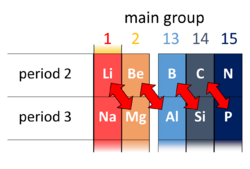Chemistry:Diagonal relationship
In chemistry a diagonal relationship is said to exist between certain pairs of diagonally adjacent elements in the second and third periods (first 20 elements) of the periodic table. These pairs (lithium (Li) and magnesium (Mg), beryllium (Be) and aluminium (Al), boron (B) and silicon (Si), etc.) exhibit similar properties; for example, boron and silicon are both semiconductors, forming halides that are hydrolysed in water and have acidic oxides.
The organization of elements on the periodic table into horizontal rows and vertical columns makes certain relationships more apparent (periodic law). Moving rightward and descending the periodic table have opposite effects on atomic radii of isolated atoms. Moving rightward across the period decreases the atomic radii of atoms, while moving down the group will increase the atomic radii.[1]
Similarly, on moving rightward a period, the elements become progressively more covalent[clarification needed], less basic and more electronegative, whereas on moving down a group the elements become more ionic, more basic and less electronegative. Thus, on both descending a period and crossing a group by one element, the changes "cancel" each other out, and elements with similar properties which have similar chemistry are often found – the atomic radius, electronegativity, properties of compounds (and so forth) of the diagonal members are similar.
It is found that the chemistry of a period 2 element often has similarities to the chemistry of the period 3 element one column to the right of it in the periodic table. Thus, the chemistry of Li has similarities to that of Mg, the chemistry of Be has similarities to that of Al, and the chemistry of B has similarities to that of Si. These are called diagonal relationships. (They are not as noticeable after B and Si.)
The reasons for the existence of diagonal relationships are not fully understood, but charge density is a factor. For example, Li+ is a small cation with a +1 charge and Mg2+ is somewhat larger with a +2 charge, so the ionic potential of each of the two ions is roughly the same. It was revealed by an examination that the charge density of lithium is much closer to that of magnesium than to those of the other alkali metals.[2] Using the Li–Mg pair (under room temperature and pressure):
- When combined with oxygen under standard conditions, Li and Mg form only normal oxides whereas Na forms peroxide and metals below Na, in addition, form superoxides.
- Li is the only group 1 element which forms a stable nitride, Li3N.[3] Mg, as well as other group 2 elements, also form nitrides.[3]
- Lithium carbonate, phosphate and fluoride are sparingly soluble in water. The corresponding group 2 salts are insoluble. (Think lattice and solvation energies).
- Both Li and Mg form covalent organometallic compounds. LiMe and MgMe2 (cf. Grignard reagents) are both valuable synthetic reagents. The other group 1 and group 2 analogues are ionic and extremely reactive (and hence difficult to manipulate).[4]
- Chlorides of both Li and Mg are deliquescent (absorb moisture from surroundings) and soluble in alcohol and pyridine. Lithium chloride, like magnesium chloride (MgCl2·6H2O) separates out from hydrated crystal LiCl·2H2O.
- Lithium carbonate and magnesium carbonate are both unstable and can produce corresponding oxides and carbon dioxide when they are heated.
Further diagonal similarities have also been suggested for carbon-phosphorus and nitrogen-sulfur, along with extending the Li-Mg and Be-Al relationships down into the transition elements (such as scandium).[5]
References
- ↑ Ebbing, Darrell and Gammon, Steven D. (2009). "Atomic Radius". General Chemistry (9th ed.). Houghton Mifflin. pp. 312–314. ISBN 978-0-618-93469-0. http://library.aceondo.net/ebooks/Chemistry/General_Chemistry_9th-Ebbing.Gammon.pdf. Retrieved 2019-02-10.
- ↑ Rayner-Canham, Geoffrey (22 December 2013). Descriptive inorganic chemistry. Overton, Tina (Sixth ed.). New York, NY. ISBN 978-1-4641-2557-7. OCLC 882867766.
- ↑ 3.0 3.1 Clark, Jim (2005). "Reactions of the Group 2 Elements with Air or Oxygen". chemguide. http://www.chemguide.co.uk/inorganic/group2/reacto2.html.
- ↑ Shriver, Duward (2006). Inorganic Chemistry (4th ed.). Oxford University Press. Li/Mg p. 259; Be/Al p. 274; B/Si p. 288. ISBN 978-0199264636.
- ↑ Rayner-Canham, Geoff (2011-07-01). "Isodiagonality in the periodic table" (in en). Foundations of Chemistry 13 (2): 121–129. doi:10.1007/s10698-011-9108-y. ISSN 1572-8463.
 |


